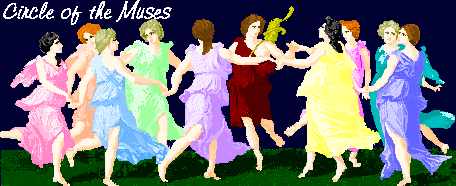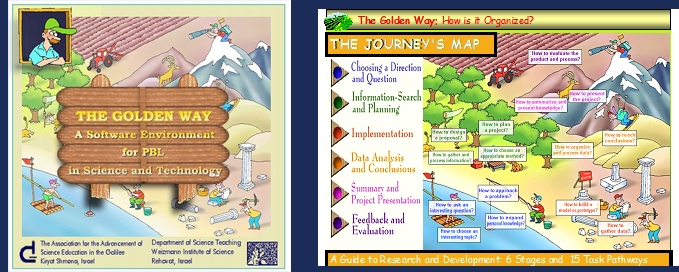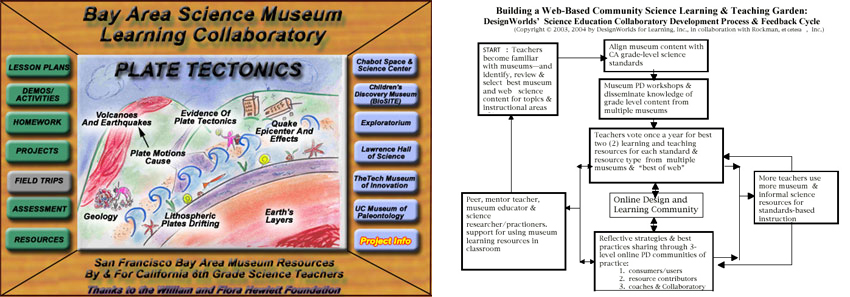Sherman Rosenfeld, PhD.
Abstract
Until recently, formal and informal science learning were considered as being quite different. Each approach was developed by different communities of practice which were relatively isolated from each other. Today, the divisions between these two approaches are blurred, largely due to the impact of information technologies but also due to educational research, which shows that both approaches are based on the same principles of learning. Today, there is a growing recognition that science learning can be advanced by bridging the gap between formal and informal science learning.
How might information technologies help bridge this gap?
The “gap” metaphor suggests these technologies might act as “bridges,” to help transport educational tools and resources in both directions, between different communities of practice. But members of the “receiving communities” should be involved as co-designers. This perspective is illustrated by two examples: (a) an intranet software environment for Project-Based Learning, (“The Golden Way”) and (b) a dynamic web-based collection of science museum resources, geared to formal science standards (“The Bay Area Museum Collaboratory”). These examples illustrate the importance of combining technological and social design, so that technology continuously evolves to fit teacher and student needs.
A. Dedication
I would like to dedicate this paper in honor of Prof. Moshe Caspi, who has been an inspiration to me, for close to 40 years. Caspi’s notion that the main goal of a person’s education should be “Self-Creation” (hitbanut in Hebrew) has many implications, one being that there should be no split between formal and informal learning environments. In other words, learning should be integrated across these different contexts, with the goal of bringing into the world different learners’ creative potentials. This premise has guided much of my educational work and is the basis of this paper.
B. Introduction: Metaphors We Live By
Because learning is so integral to being human, we often seem to take it for granted. Lakoff and Johnson [1] suggest that our thoughts and actions are governed by our own metaphors, of which we are unaware. For example, most of us unconsciously regard arguments in terms of war. As they write, our everyday language is colored with this unconscious metaphor (e.g., “Your claims are indefensible.” “His criticisms were right on target.”). If it is true that “metaphor is as much a part of our functioning as our sense of touch, and as precious,” then perhaps we should ask ourselves: “What are our metaphors of learning and teaching? About the process of developing technologies to promote learning and teaching?”
One metaphor is connected to Greek myths surrounding the Muses, daughters of Zeus who presided over the arts and sciences. People who were engaged in these pursuits often sought the inspiration of the Muses in special shrines called “mouseion,” the basis of the modern word for “museum.” I suggest that we think of learning and teaching, as well as the process of developing technologies to promote learning and teaching, in terms of “dancing with the Muses.” (See Fig. 1) [2]
I will use another metaphor when discussing informal and formal science education: “bridging the gap.” [3] These two metaphors – dancing with the Muses and bridging the gap – will help guide the central argument of this paper.

C. A Tale of Two Learning Cultures
1. Background. In the past, science learning was characterized as taking place in two different contexts: formal and informal. Even the terms positioned these “two cultures” as opposite from each other. Formal learning took place in schools; it was compulsory, structured, teacher-led, teacher-centered, with fewer unintended outcomes and focused on solitary work. Informal learning took place in places like museums; it was voluntary, unstructured, learner-led, learner-centered, with many unintended outcomes, and focused on social intercourse. [4]
Moreover, these two cultures, on the whole, were isolated from each other. A different “community of practice” was connected with each culture. Curriculum and research efforts in formal science learning were guided by academic institutions and Departments of Education, while efforts to promote informal science learning environments were undertaken by different people – museum curators and volunteer staff [5]. These two communities of practice rarely interacted with each other; their concerns seemed to be different, they participated in different conferences and published their educational research in different journals.
2. A New Reality. This remarkable isolation is no longer the norm. Informal science education is now a “mainstream topic” within the mainstream science education community, at least in the United States and U.K. Research articles on “free-choice learning” are common in journals that once refused to publish them. [6] Organizations to connect informal science learning environments with schools exist in the U.S. and Europe. [7] In short, the “dichotomy” approach, presented above, has given way to a “hybrid” approach, in which formal learning contexts (such as schools) are encouraged to adopt informal learning methods (such as free-choice exploration).
A major reason why the distinctions between formal and informal learning have become blurred is because of the advances of information technology, especially computer-mediated communications, and modern society’s shift from an industrial-based to a knowledge-based society. [8]-[9]. Also, educational research shows that both formal and informal learning are based on the same principles of learning, and that both learning contexts can include a variety of learning methods. For example, it is increasingly clear that school learning needs to be based on “learner-centered” environments, i.e., “environments that pay careful attention to the knowledge, skills, attitudes and beliefs that learners bring to the educational setting.” [10] However, while informal learning experiences can enrich school science, “we have a poor idea about how these experiences can best be integrated into the (school) curriculum.” [3]
How might educational technology can help “bridge the gap” between formal and informal learning environments? The “gap” metaphor suggests these technologies might act as “bridges,” to help transport educational tools and resources in both directions, between what are still different communities of practice. But who should design these bridges and determine their criteria of success? My perspective is that the “receiving communities” should be involved in the “bridge-building” efforts, as co-designers. In the following paragraphs, I present two examples of such efforts.
3. The Golden Way. “Project-Based Learning (PBL) in Science and Technology is a teaching and learning approach which has been developed and implemented in Israeli schools for the past 14 years at the Weizmann Institute. [11]-[13]. Its goal is to incorporate students’ “free-choice learning” into the formal science and technology curriculum, using PBL. In order to guide teachers and their 7th-12th grade students in this approach, a networked software environment was developed, called “The Golden Way,” which included detailed. [14] Using the metaphor of a “guided journey,” which students undertake with subject-matter topics of their choice, the software was designed to provide specific pedagogical guidance (see Fig. 2).

The software was pilot-tested and co-designed with practicing PBL teachers over several trials, spanning a number of years. Each revision reflected an improved user interface and more effective student activities. Participating teachers from about 50 schools communicate with each other online and via regular conferences. This community of practice makes it possible for the teachers to distribute and learn about “best practices” while participating in the co-design of new PBL activities and software applications.
4. The Bay Area Science Education Collaboratory. How might science museum resources be aligned to the science standards and effectively used by practicing teachers in their schools? This question catalyzed an ambitious effort to make accessible the online and physical resources of 6 San Francisco Bay Area science museums, including the Exploratorium, to 6th grade science teachers. The resulting dynamic website is being co-designed and used by an “online design and learning community” of 6th grade teachers (Fig. 3). This community of practice engages in professional development on three levels: as consumers/users, as resource contributors and as coaches/editors. [15]

An evaluation of this project showed that the participating teachers increased their use of museum web services in the design of their classroom teaching. [16]
D. Conclusions
These examples illustrate how information technology can help bridge the gap between formal and informal science learning. Note that each technology (networked software and a dynamic web-based resource, respectively) brings “free-choice learning” into the formal classroom. Each technology serves as a “bridge” for connecting two (once separate, now overlapping) communities of practice.
It is crucial to recognize the role that “participatory design” played in the design of these technologies, both used as integral parts of professional development programs. In the former case, practicing 7th-12th grade PBL teachers were engaged in co-designing the software and its implementation in their schools. In the latter case, practicing 6th-grade teachers were engaged in co-designing the web-based resource they use in their classrooms.
Each product resulted from combining technological and social design, so that the technology continuously evolved to fit teacher and student needs.
It is also necessary to note the limitations of these examples, in order to avoid the common pitfalls of educational technology. [17] For example, in each case the “participatory design” of the teachers worked well during the professional development framework, when outside experts were involved. But when the teachers were “on their own,” without outside support, their use of these technologies dropped significantly.
Nonetheless, these examples illustrate the importance of linking participatory design with the evolution of technological tools. In effect, these examples illustrate how diverse individuals — teachers, museum professionals, students, research scientists, subject-matter experts, software designers and the like — can be linked together as co-creators, “dancing with the Muses” in the process of learning. In this dance, sometimes one gains inspiration from others and sometimes one gives inspiration to others. A community of practice engages in the creation of a technology to help reinforce its own shared practices, and the technology enhances the community’s practice, so that both the community and the technology co-evolve over time. [18]
E. References and Notes
[1] Lakoff, G. and Johnson, M. (1980). Metaphors We Live by. Chicago: University
of Chicago Press.
[2] There are many other possibilities. For example, see “Learning Metaphors” by
Lawley and Thompkins. http://www.devco.demon.co.uk/LearningMetaphors.html
[3] Hofstein, A. and Rosenfeld, S. (1996) “Bridging the Gap Between Formal and
Informal Science Learning.” Studies in Science Education, 28:87-112.
[4] Modified from Wellington, J. (1990). “Formal and Informal Learning in Science:
the Role of the Interactive Science Centers,” Physics Education, 25. 247-252.
[5] Historically, the function of public education in museums, zoos and aquaria,
(for school groups and the casual visitor) evolved relatively late, after the
function of collecting and conserving the collections.
[6] It is worth noting the important role played by John Falk, Lynn Dierking and their
colleagues from the Institute of Learning Innovations, in this development.
[7] CILS (the Center for Informal Learning in Schools) is an NSF-funded
organization in the US. An European counterpart (PENCIL) has just been formed.
[8] For an excellent discussion of how the Knowledge Age will continue to affect
education, see: Trilling, B. and Hood, P. (1999). “Learning, Technology and
Education Reform in the Knowledge Age, or, ‘We’re Wired, Webbed, and
Windowed, Now What?’” Educational Technology, May-June, pp. 5-18.
[9] Stewart, T.A. (1997). Intellectual Capital: The New Wealth of Organizations. N.Y.:
Doubleday. Stewart quotes 1991 as the year when U.S. spending for information
technology (computers and telecommunications hardware and software) was greater
than its spending for Industrial Age capital goods: 1991. He calls this “Year One”
of the Knowledge Age.
[10] Bransford, J., Brown, A. and Cocking, R. (Eds). How People Learn: Brain,
Mind, Experience and School. Washington: National Academy of Sciences.
[11] Rosenfeld, S. and Ben-Hur, Y. (2001). “Project-Based Learning (PBL) in
Science and Technology: A Case Study of Professional Development.” In
Valanides, N. (Ed), Science and Technology Education: Preparing Future
Citizens: Proceedings of the 1st IOSTE Symposium in Southern Europe.
Paralimni, Cyprus.
[12] Rosenfeld, S., Loria, Y., Scherz, Z and Eylon, B. (1999). “An ‘Interlocking
Loops’ Model to Support Teacher Development and School Change in Project-
Based Learning.” Proceedings of the European Association of Research on
Learning and Instruction (EARLI). University of Gothenburg, Sweden.
[13] For educational and activities relating to PBL, see www.PBLnet.org
[14] Loria, Y., Shaltiel, L., Pieterse, E., Rosenfeld, S. (1999). “The Development of
Software to Support Teachers and their Students in PBL: ‘The Golden Way’.”
Conference Proceedings of the European Association of Research on Learning
and Instruction (EARLI). University of Gothenburg, Sweden.
[15] DesignWorlds for Learning, “Bay Area Science Education Collaboratory.”
http://www.designworlds.com/Hewlett/BA_ScienceCollab/index.html
[16] Kahn, T. and Rockman, S. (2003). Bay Area Science Education Collaboratory
Project: Final Report. See “Links” on website listed in [14].
[17] Cuban, L. (1986). Teachers and Machines: The Classroom Use of Technology
Since 1920. N.Y., Teachers College Press.
[18] One of the most significant questions, in this collective work, is how to guide
people from different disciplines (each having different priorities, thinking styles
and values) to cooperate effectively. An excellent treatment of this problem
(with practical solutions) can be found in: Kim, S. “Interdisciplinary Cooperation.”
In Laurel, B. (Ed.) The Art of Human-Computer Interface Design N.Y.: Addison-
Wesley, pp. 31-44.
Acknowledgements
The author would like to thank Ted Kahn for discussions on an earlier draft of this paper.
